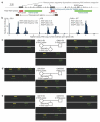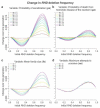Evolutionary genetics of the human Rh blood group system
- PMID: 22367406
- PMCID: PMC3378649
- DOI: 10.1007/s00439-012-1147-5
Evolutionary genetics of the human Rh blood group system
Abstract
The evolutionary history of variation in the human Rh blood group system, determined by variants in the RHD and RHCE genes, has long been an unresolved puzzle in human genetics. Prior to medical treatments and interventions developed in the last century, the D-positive (RhD positive) children of D-negative (RhD negative) women were at risk for hemolytic disease of the newborn, if the mother produced anti-D antibodies following sensitization to the blood of a previous D-positive child. Given the deleterious fitness consequences of this disease, the appreciable frequencies in European populations of the responsible RHD gene deletion variant (for example, 0.43 in our study) seem surprising. In this study, we used new molecular and genomic data generated from four HapMap population samples to test the idea that positive selection for an as-of-yet unknown fitness benefit of the RHD deletion may have offset the otherwise negative fitness effects of hemolytic disease of the newborn. We found no evidence that positive natural selection affected the frequency of the RHD deletion. Thus, the initial rise to intermediate frequency of the RHD deletion in European populations may simply be explained by genetic drift/founder effect, or by an older or more complex sweep that we are insufficiently powered to detect. However, our simulations recapitulate previous findings that selection on the RHD deletion is frequency dependent and weak or absent near 0.5. Therefore, once such a frequency was achieved, it could have been maintained by a relatively small amount of genetic drift. We unexpectedly observed evidence for positive selection on the C allele of RHCE in non-African populations (on chromosomes with intact copies of the RHD gene) in the form of an unusually high F( ST ) value and the high frequency of a single haplotype carrying the C allele. RhCE function is not well understood, but the C/c antigenic variant is clinically relevant and can result in hemolytic disease of the newborn, albeit much less commonly and severely than that related to the D-negative blood type. Therefore, the potential fitness benefits of the RHCE C allele are currently unknown but merit further exploration.
Figures




Similar articles
-
Clinically relevant RHD-CE genotypes in patients with sickle cell disease and in African Brazilian donors.Blood Transfus. 2016 Sep;14(5):449-54. doi: 10.2450/2016.0275-15. Epub 2016 Apr 28. Blood Transfus. 2016. PMID: 27177398 Free PMC article.
-
A Tutsi family harbouring two new RHCE variant alleles and a new haplotype in the Rh blood group system.Vox Sang. 2020 Jul;115(5):451-455. doi: 10.1111/vox.12905. Epub 2020 Mar 20. Vox Sang. 2020. PMID: 32196693
-
RH diversity in Mali: characterization of a new haplotype RHD*DIVa/RHCE*ceTI(D2).Transfusion. 2015 Jun;55(6 Pt 2):1423-31. doi: 10.1111/trf.13109. Epub 2015 Apr 10. Transfusion. 2015. PMID: 25857637
-
Molecular genetics of RH and its clinical application.Transfus Clin Biol. 2006 Mar-Apr;13(1-2):4-12. doi: 10.1016/j.tracli.2006.02.011. Epub 2006 Mar 24. Transfus Clin Biol. 2006. PMID: 16563832 Review.
-
Molecular genetics of RH.Vox Sang. 2000;78 Suppl 2:109-15. Vox Sang. 2000. PMID: 10938938 Review.
Cited by
-
RHD PCR of D-Negative Blood Donors.Transfus Med Hemother. 2013 Jun;40(3):172-81. doi: 10.1159/000351604. Epub 2013 May 8. Transfus Med Hemother. 2013. PMID: 23922542 Free PMC article.
-
Rhesus negative males have an enhanced IFNγ-mediated immune response to influenza A virus.Genes Immun. 2022 Apr;23(2):93-98. doi: 10.1038/s41435-022-00169-5. Epub 2022 Apr 15. Genes Immun. 2022. PMID: 35428875 Free PMC article.
-
Fetal RHD Genotyping Using Real-Time Polymerase Chain Reaction Analysis of Cell-Free Fetal DNA in Pregnancy of RhD Negative Women in South of Iran.Int J Fertil Steril. 2016 Apr-Jun;10(1):62-70. doi: 10.22074/ijfs.2016.4770. Epub 2016 Apr 5. Int J Fertil Steril. 2016. PMID: 27123202 Free PMC article.
-
Association of a germline copy number polymorphism of APOBEC3A and APOBEC3B with burden of putative APOBEC-dependent mutations in breast cancer.Nat Genet. 2014 May;46(5):487-91. doi: 10.1038/ng.2955. Epub 2014 Apr 13. Nat Genet. 2014. PMID: 24728294 Free PMC article.
-
More evidence for widespread antagonistic pleiotropy in polymorphic disease alleles.Front Genet. 2024 Jun 17;15:1404516. doi: 10.3389/fgene.2024.1404516. eCollection 2024. Front Genet. 2024. PMID: 38952711 Free PMC article. Review.
References
-
- Allison AC. The distribution of the sickle-cell trait in East Africa and elsewhere, and its apparent relationship to the incidence of subtertian malaria. Trans R Soc Trop Med Hyg. 1954;48:312–8. - PubMed
-
- Avent ND, Reid ME. The Rh blood group system: a review. Blood. 2000;95:375–87. - PubMed
-
- Barreiro LB, Laval G, Quach H, Patin E, Quintana-Murci L. Natural selection has driven population differentiation in modern humans. Nat Genet. 2008;40:340–5. - PubMed
Publication types
MeSH terms
Substances
Grants and funding
LinkOut - more resources
Full Text Sources
Other Literature Sources
Medical

